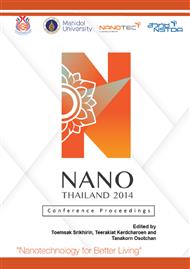p.215
p.223
p.227
p.231
p.237
p.242
p.246
p.251
p.255
Effect of ZnO on a Superhydrophilic Self-Cleaning Properties of TiO2/SiO2 Thin Film on Glass Slide Substrate
Abstract:
This work aims to study the effect of ZnO containing in TiO2/SiO2 film on the superhydrophilic property after exposed to different types of light. The metal solutions were prepared by sol-gel technique and the film was deposited on glass slides by dip coating method. The parameter studied was the amount of ZnO in the TiO2/SiO2 film. The contents of ZnO were 5-20% weight (increased by 5%). The amount of TiO2 was constant at 30% weight. The obtained films were analyzed for their roughness. The results indicated that film roughness changed according to the ZnO contents. With 5%ZnO in the thin film, the roughness was 0.726 nm while 20%ZnO obtained the roughness of 2.128 nm. UV-Vis spectrophotometer was used for measuring of transmittance of films. At wavelength of 550 nm, the transmittances of each film were greater than 90%. Band gap energy of each film was calculated from the transmittance data. It was found that the average band gap energy of the films was 2.47 eV. Then, the films contained various amount of ZnO were grouped into 2 sets. The first set was exposed to visible light while the other set was exposed to UV. The duration of exposure was 5 hr. Both sets of films after exposed to any light were kept in a black box controlled relative humidity of 85%. Each film was measured contact angle every day. It was found that the 30%TiO2/5%Zn/SiO2 film exposed to visible light showed the best superhydrophilic property. The contact angle was about 0-5° within 3 days. This may due to the reduction of band gap energy in the presence of ZnO in TiO2/SiO2 films to 2.41 eV and the roughness of the film.
Info:
Periodical:
Pages:
237-241
Citation:
Online since:
December 2015
Keywords:
Price:
Сopyright:
© 2016 Trans Tech Publications Ltd. All Rights Reserved
Share:
Citation:


